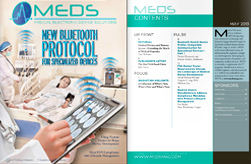First published by the International Electrotechncial Commission (IEC)[1] in 1977, IEC 60601 has become the most widely recognized international family of standards dealing with the safety of medical electrical equipment and systems. The third edition of IEC 60601-1 published in 2005 introduced a major new paradigm for dealing with the safety of electrically powered medical devices in direct patient contact.
The paradigm that underpinned the first and second editions of IEC 60601-1 focused on managing risks directly caused by physical hazards when medical electrical equipment or systems are used under normal conditions and in the single fault condition. The general standard and the particular standards built on it did this by providing tried and true risk control measures or test methods to measure the effectiveness of the risk control measures deployed by the manufacturer. This made the IEC 60601 family a very useful set of standards to support “type testing” of medical electrical equipment and systems. In a type test, a representative sample of the equipment is evaluated to determine if the equipment, as designed and manufactured, can meet the requirements of the standard.
In the third edition of IEC 60601-1, the safety paradigm was expanded. The standard retained most of the basic safety requirements from the first and second editions. Many of these requirements were updated to include state-of-the-art concepts in areas such as insulation coordination and greater alignment with the requirements of the IEC standards for information technology equipment when dealing with operator safety. The patient safety requirement remained aligned with the second edition of IEC 60601-1. In addition, new basic safety requirements were added in a number of areas. This included a number of new requirements in the section of the standard dealing with mechanical safety.
The third edition added new requirements dealing with functional safety, which is referred to in the standard as “essential performance.” The manufacturer must demonstrate that the risk control measures they have deployed assure that the medical electrical equipment or system not only maintains basic safety but that it remains functionally safe if the loss or degradation of a clinical function of the equipment beyond the performance limits specified by the manufacturer would result in an unacceptable risk to the patient, operator, or a third party. This does not mean that the equipment can never fail. It does mean that the manufacturer must deploy risk control measures designed to deal with the risks that arise if the equipment cannot maintain within prescribed limits those clinical functions that have been determined to be essential to safety—the essential performance.
To achieve this, the IEC 66001 family has increased its reliance on process requirements in areas such as software development or user interface design where a pass-fail test is inadequate to demonstrate safety. First among these process requirements is the application of major elements of the risk management process described in ISO 14971. Elements of risk management are used in a number of places in the standard to supplement the tried and true measures of the first and second editions.
Several of these process standards deal with the product lifecycle and require, for example, feedback loops that look at data generated during the production and post-production phases of the lifecycle. However, the IEC 60601 family is still intended to be a standard for design evaluation.
In 2008, IEC Technical Committee 62 decided that it was appropriate for Subcommittee 62A to initiate a project to develop the first amendment to IEC 60601-1:2005. The goals for the amendment are to:
- Resolve a few issues left over from the third edition project.
- Improve some of the new test methods introduced into the third edition.
- Clarify some of the requirements for risk management within the standard and provide additional guidance on its application.
- Provide additional guidance on determination of essential performance.
The overall objective of the amendment is to improve the usefulness of the standard as a comprehensive tool for demonstrating basic safety and essential performance.
The target set by the technical committee was to have the first amendment published by mid-2012.
The project has been proceeding on schedule and just completed the Enquiry Stage on August 12, 2011. The Enquiry Stage is the major ballot by the IEC National Committee members of the technical committee to determine if a document is sufficiently mature to move to a final up-or-down ballot as a Final Draft International Standard. At the Enquiry Stage, a National Committee is required to state their specific objections if they vote negative, but may submit technical comments even if they vote in favor of advancing the document.
When the voting on Amendment 1 to IEC 60601-1:2005 closed on August 12th, 21 of the 27 participating member countries of the committee agreed to the circulation of the draft as a Final Draft International Standard. Four participating countries abstained, one country did not vote, and one country voted against advancing the draft.
Although the participating member countries voted overwhelming in favor of advancing the draft, ten countries submitted 424 separate comments that must be resolved before the document can advance. During the fall of 2011, the committee will be working to resolve these comments, roughly half of which are editorial in nature, and to prepare the final draft text. The final draft should be submitted to IEC for registration as a Final Draft International Standard early in the first quarter of 2012. Following the preparation of a French translation and a two-month up-or-down vote, the amendment should be ready for publication by late June 2012.
ABSTRACT
The third edition of IEC 60601-1 was published in 2005. Since late 2008, IEC Subcommittee 62A has been working to develop the first amendment to the third edition. In August, the draft amendment approved to advance to the Final Draft International Standard Stage with publication of the amendment targeted for mid-2012.
[1] Founded in 1906, the International Electrotechnical Commission is the world’s leading organization for the preparation and publication of International Standards for all electrical, electronic and related technologies. These are known collectively as “electrotechnology.” All IEC International Standards are fully consensus-based and represent the needs of key stakeholders of every nation participating in IEC work. Every member country, no matter how large or small, has one vote and a say in what goes into an IEC International Standard.


